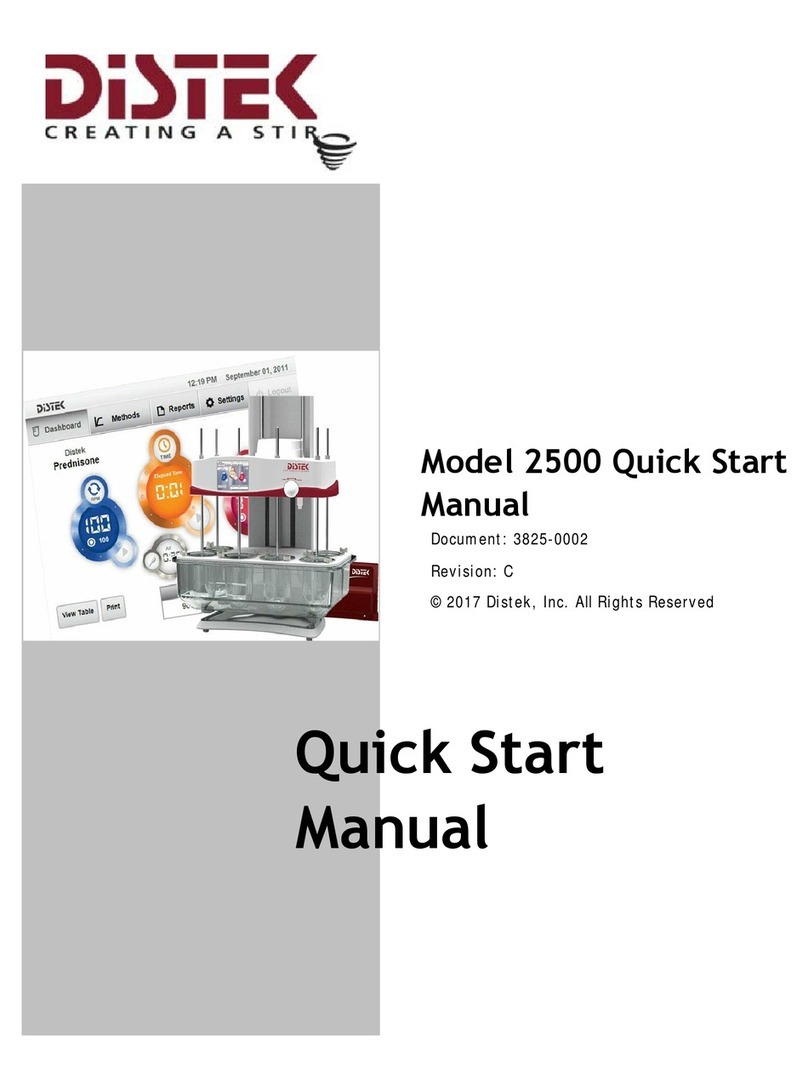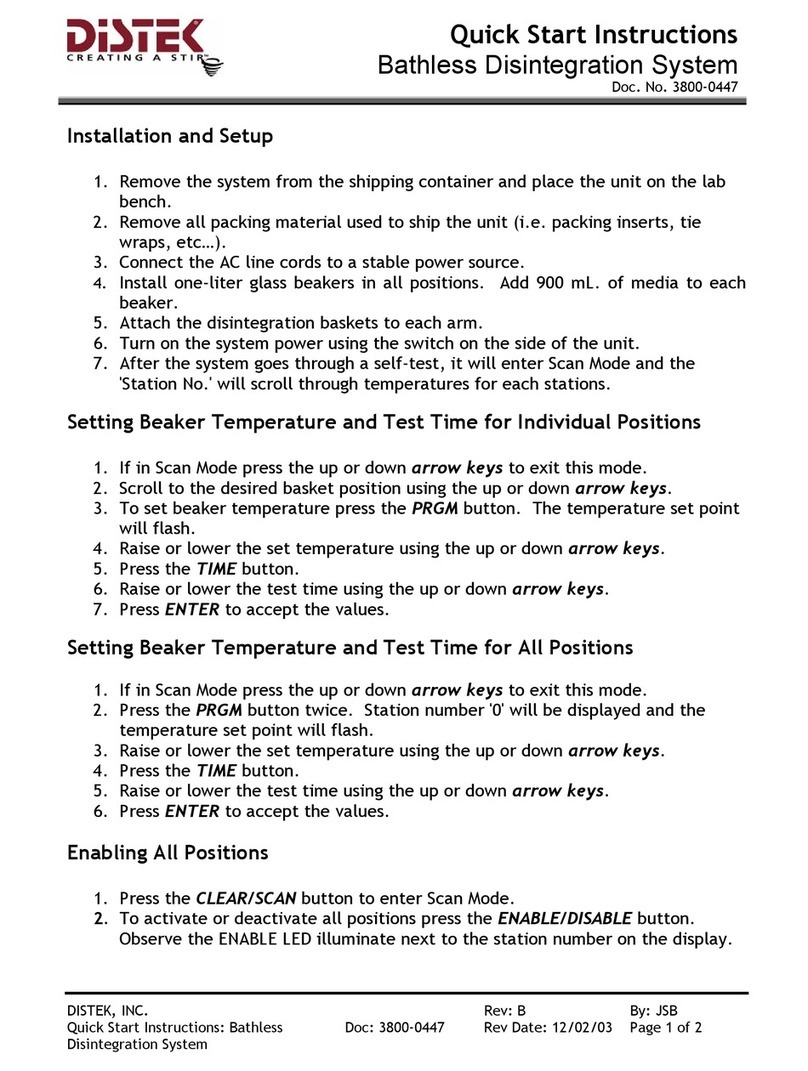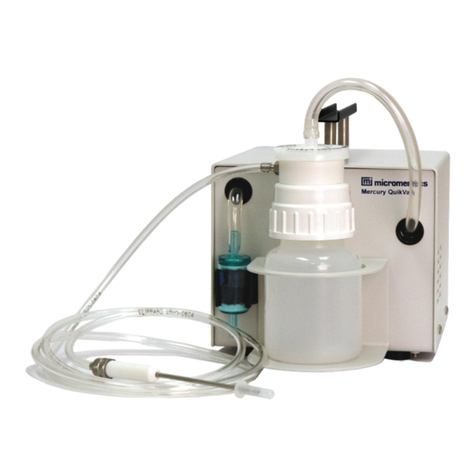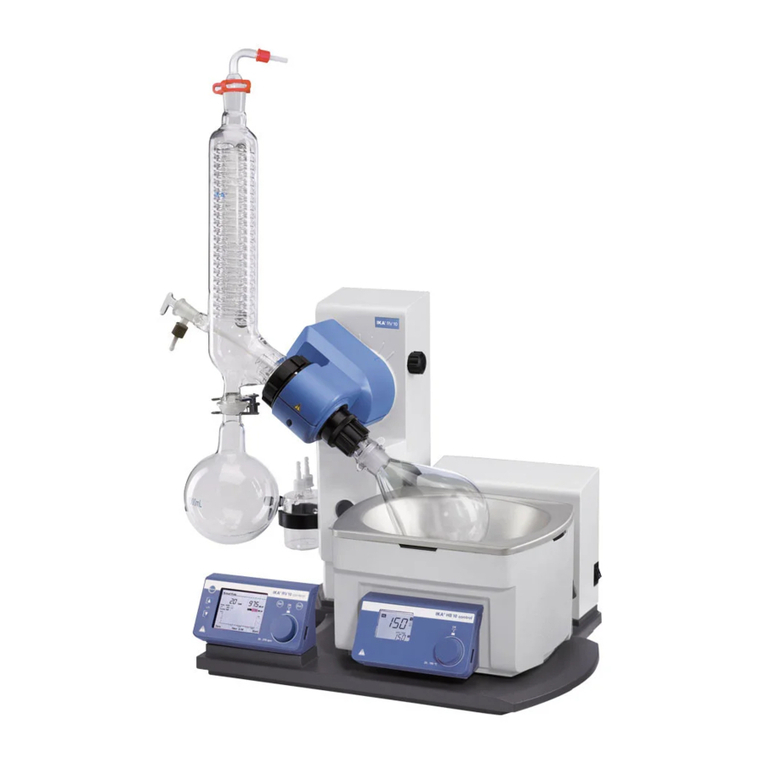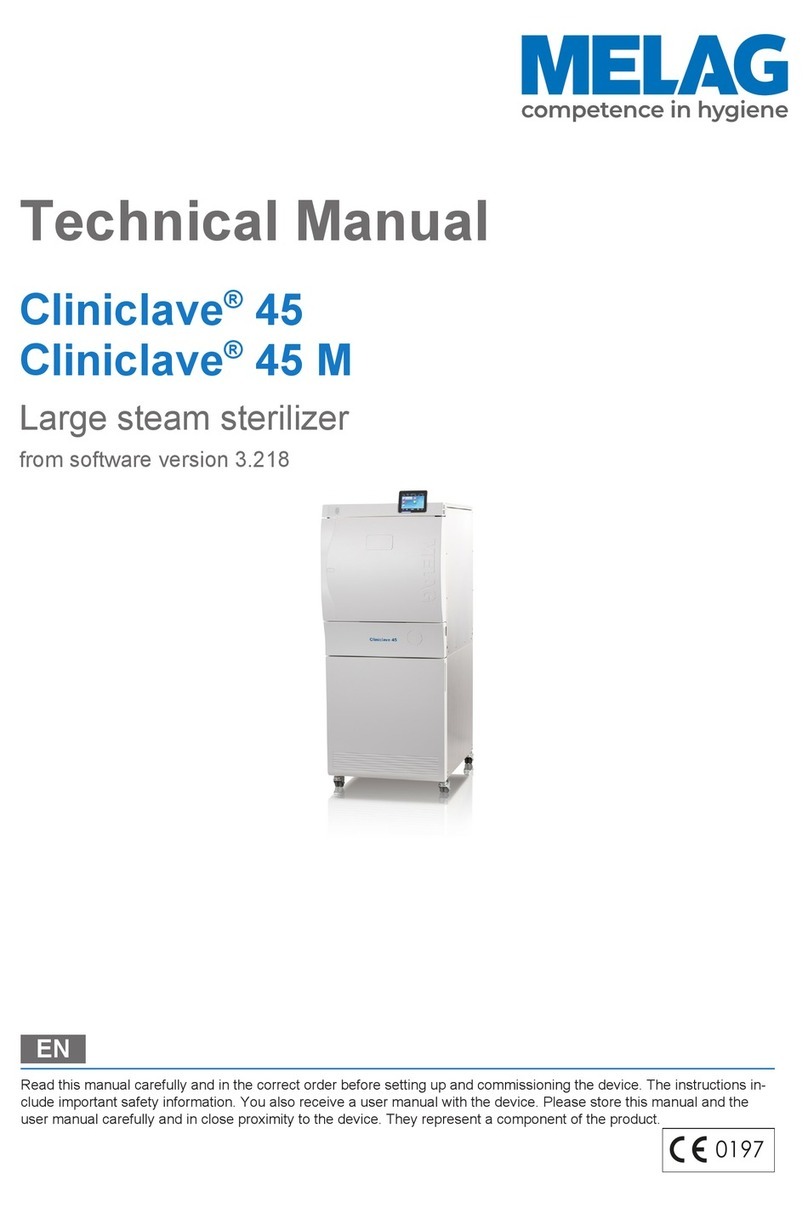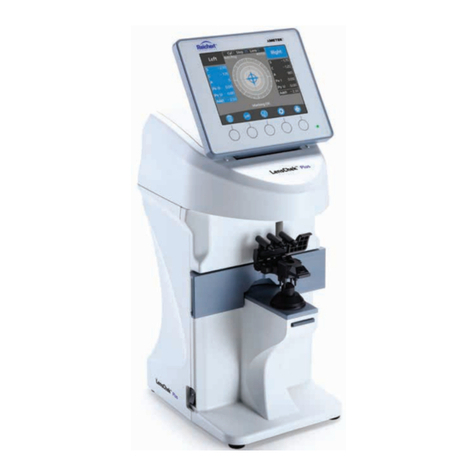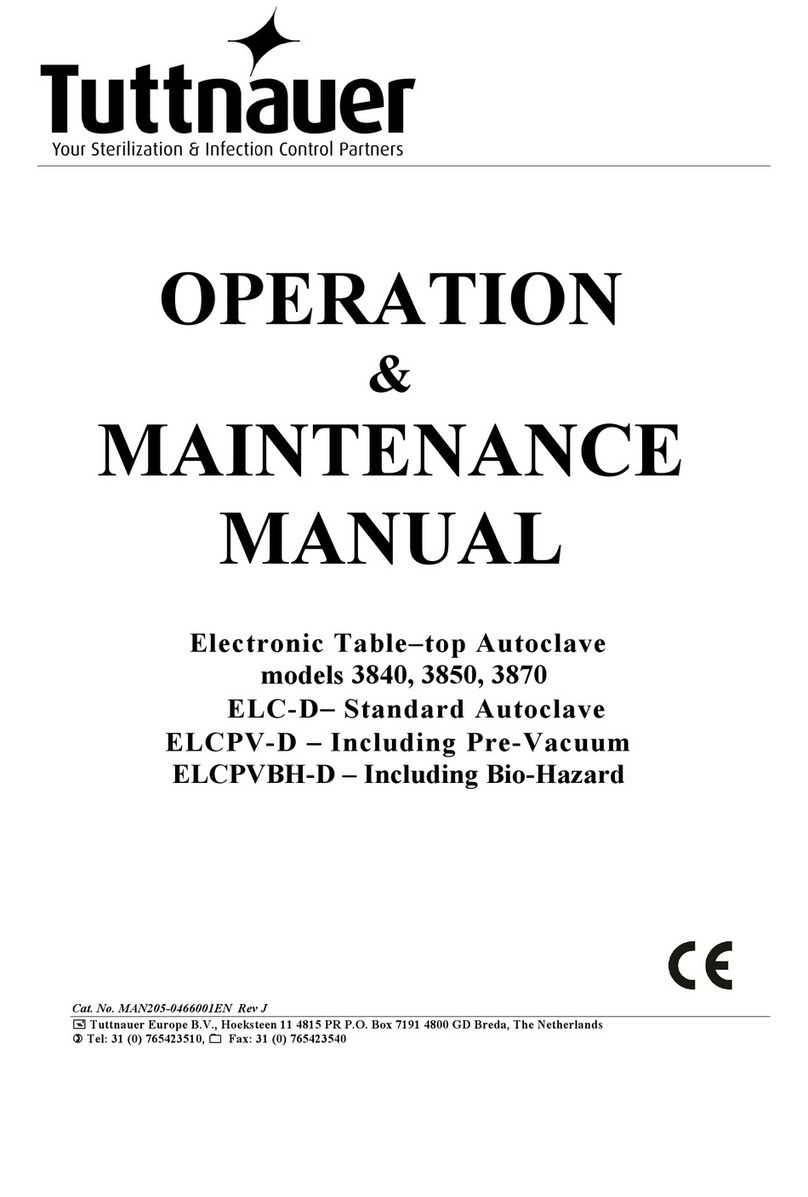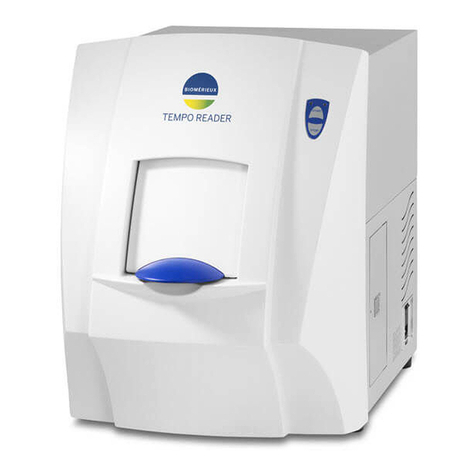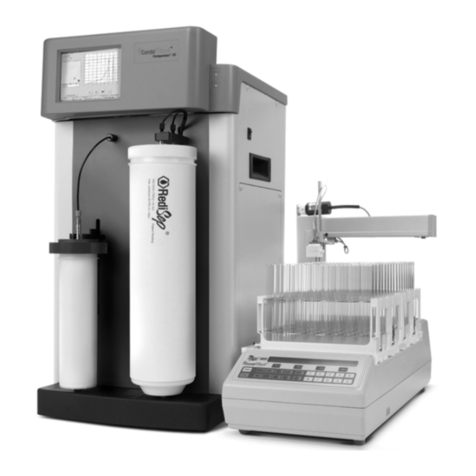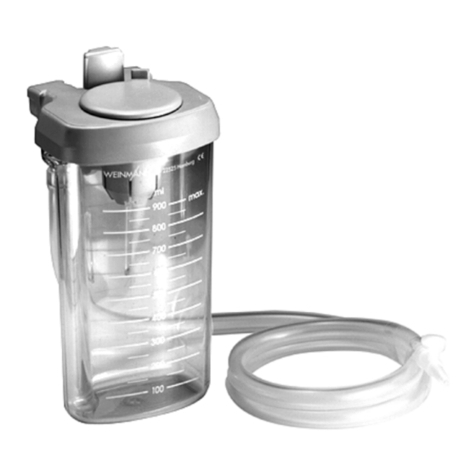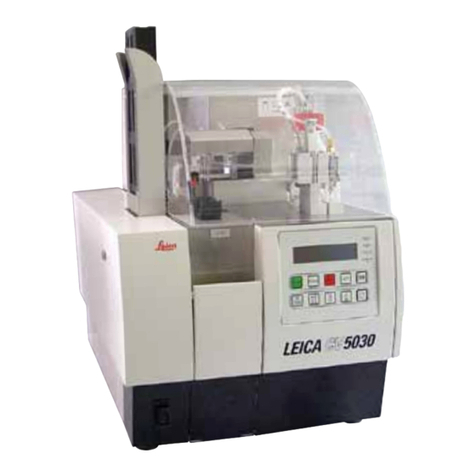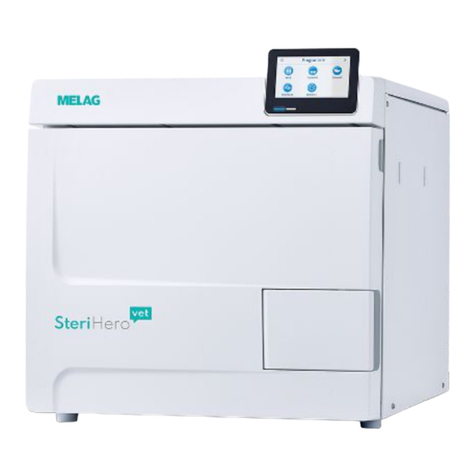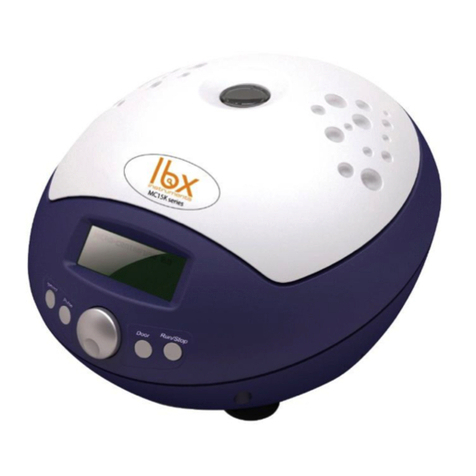Distek 2500 Select User manual

© 2015-2017 Distek, Inc. All Rights Reserved
Model 2500
Operation
Manual
Document: 3825-0001 Rev. F

Model 2500
Operation Manual
Document 3825-0001 Rev. F
© Distek, Inc.
121 North Center Dr. • North Brunswick, NJ 08902
Phone 732.422.7585 • Fax 732.422.7310
http://www.distekinc.com

All rights reserved. No part of this work may be reproduced in any form or by any means - graphic,
electronic, or mechanical, including photocopying, recording, taping, or information storage and retrieval
systems - without the written permission of Distek, Inc.
Products that are referred to in this document may be either trademarks and/or registered trademarks of
the respective owners. Distek, Inc. makes no claim to these trademarks.
The information contained in the document is subject to change without notice.
While every precaution has been taken in the preparation of this document, Distek, Inc. assumes no
responsibility for errors or omissions, or for damages resulting from the use of information contained in
this document or from the use of programs and source code that may accompany it. In no event shall
Distek, Inc. be liable for any loss of profit or any other commercial damage caused or alleged to have been
caused directly or indirectly by this document.
Model 2500
© 2015-2017 Distek, Inc. All Rights Reserved
DISTEK, INC.
121 North Center Drive
North Brunswick, NJ 08902
Tel. 732.422.7585
Website: http://www.distekinc.com

4Model 2500
© 2015-2017 Distek, Inc. All Rights Reserved
Table of Contents
Chapter I Introduction 8
................................................................................................................................... 91 Distek Model 2500 Overview
................................................................................................................................... 112 Instrument Specification
................................................................................................................................... 123 Notices
................................................................................................................................... 144 Safety Information
................................................................................................................................... 155 Site Requirements
.......................................................................................................................................................... 16
Physical Site Consideration
.......................................................................................................................................................... 17
Electrical Requirements
................................................................................................................................... 186 Environmental Conditions
.......................................................................................................................................................... 19
Ambient Laboratory Humidity
.......................................................................................................................................................... 20
Ambient Laboratory Temperature
.......................................................................................................................................................... 21
Air Quality Considerations
.......................................................................................................................................................... 22
Environmental Considerations
Chapter II Installation 24
................................................................................................................................... 251 Unpacking
................................................................................................................................... 262 Leveling
................................................................................................................................... 273 AC Power Installation
................................................................................................................................... 284 TCS Installation
................................................................................................................................... 305 Vessel Installation
................................................................................................................................... 326 Shaft Installation
.......................................................................................................................................................... 33
Standard Shafts
.......................................................................................................................................................... 34
RTD Shafts
................................................................................................................................... 367 Paddle Installation
................................................................................................................................... 378 Basket Installation
................................................................................................................................... 389 Vessel Covers
Chapter III Installing Accessories 40
................................................................................................................................... 411 TempChek
................................................................................................................................... 422 Dosage Delivery System (DDS)
................................................................................................................................... 453 Printers
.......................................................................................................................................................... 46
Dedicated Instrument Printer
................................................................................................................................... 474 Distek Cipher Software
................................................................................................................................... 485 Agilent 8453 UV-Vis
................................................................................................................................... 496 Waters HPLC
Chapter IV Graphic User Interface (GUI) 51
................................................................................................................................... 521 2500 Dashboard
................................................................................................................................... 542 2500 RTD Dashboard

5ContentsModel 2500
© 2015-2017 Distek, Inc. All Rights Reserved
................................................................................................................................... 563 2500 Select Dashboard
................................................................................................................................... 584 Apparatus ID
................................................................................................................................... 595 Methods
................................................................................................................................... 606 Reports
................................................................................................................................... 617 Settings
................................................................................................................................... 628 Logout
................................................................................................................................... 639 On-Screen Keyboard
Chapter V Operation 65
................................................................................................................................... 661 Turning On the Instrument
................................................................................................................................... 672 Operational Checkout
................................................................................................................................... 683 Height Adjustment
.......................................................................................................................................................... 69
Baskets and Paddles
.......................................................................................................................................................... 73
Modified Baskets
.......................................................................................................................................................... 75
Modified Paddles
.......................................................................................................................................................... 77
Intrinsic
................................................................................................................................... 794 Manual Run
.......................................................................................................................................................... 79
2500 with Standard Shafts
.......................................................................................................................................................... 81
2500 RTD .......................................................................................................................................................... 83
2500 Select
................................................................................................................................... 855 Create a New Method
................................................................................................................................... 886 Edit Method
................................................................................................................................... 907 Method Run
.......................................................................................................................................................... 91
Selecting a Method
.......................................................................................................................................................... 92
Using the Dosage Delivery System
.......................................................................................................................................................... 93
Simultaneous Drop Using Baskets
......................................................................................................................................................... 93
2500 with Standard Shafts
......................................................................................................................................................... 97
2500 RTD-Select
.......................................................................................................................................................... 101
Simultaneous Drop Using Paddles
......................................................................................................................................................... 101
2500 with Standard Shafts
......................................................................................................................................................... 105
2500 RTD-Select
.......................................................................................................................................................... 109
Staggered Drop Using Baskets
......................................................................................................................................................... 109
2500 with Standard Shafts
......................................................................................................................................................... 114
2500 RTD-Select
.......................................................................................................................................................... 119
Staggered Drop Using Paddles
......................................................................................................................................................... 119
2500 with Standard Shafts
......................................................................................................................................................... 124
2500 RTD-Select
................................................................................................................................... 1298 Report Summary
................................................................................................................................... 1319 User Setup
.......................................................................................................................................................... 132
New User .......................................................................................................................................................... 135
Edit User .......................................................................................................................................................... 137
Delete User
................................................................................................................................... 13810 System Settings
.......................................................................................................................................................... 139
TCS Schedule
.......................................................................................................................................................... 141
Temperature Calibration
......................................................................................................................................................... 142
Accessing Calibration
......................................................................................................................................................... 144
TCS Calibration Using TempChek

6Model 2500
© 2015-2017 Distek, Inc. All Rights Reserved
......................................................................................................................................................... 146
TCS Calibration Using Reference
......................................................................................................................................................... 147
Shaft Sensor Calibration Using TempChek
......................................................................................................................................................... 150
Shaft Sensor Calibration Using Reference
.......................................................................................................................................................... 152
System Setup
......................................................................................................................................................... 156
Advanced Setup
......................................................................................................................................................... 159
LCD Calibration
.......................................................................................................................................................... 161
Service .......................................................................................................................................................... 164
Instrument Validation
.......................................................................................................................................................... 166
Battery Monitor
.......................................................................................................................................................... 168
Help
Chapter VI Maintenance 170
................................................................................................................................... 1711 General Maintenance
................................................................................................................................... 1722 Lubrication
................................................................................................................................... 1733 Belt Tension
Chapter VII Troubleshooting 175
................................................................................................................................... 1761 Prompted Messages
.......................................................................................................................................................... 177
General Messages
.......................................................................................................................................................... 180
Error Messages
.......................................................................................................................................................... 183
Warning Messages
.......................................................................................................................................................... 184
Service Messages
................................................................................................................................... 1852 LCD Display
................................................................................................................................... 1863 Power Supply
................................................................................................................................... 1874 Heating
................................................................................................................................... 1885 Stirring
................................................................................................................................... 1896 I/O Communication
................................................................................................................................... 1907 Temperature Calibration
................................................................................................................................... 1918 Mechanical
Chapter VIII Appendix A: Spare Parts and Accessories 194
Chapter IX Appendix B: Pre-Installation
Considerations 197
Chapter X Appendix C: Sample Printouts 199
Index 205

Introduction
Chapter I

IntroductionModel 2500 8
© 2015-2017 Distek, Inc. All Rights Reserved
1 Introduction
Model 2500 Overview
Instrument Specification
Notices
Safety Information
Site Requirements
Environmental Conditions
This chapter contains an overview of the instrument and safeguards that need to be followed when
installing and using the instrument.

IntroductionModel 2500 9
© 2015-2017 Distek, Inc. All Rights Reserved
1.1 Distek Model 2500 Overview
W elcome to a new innova tion in D issolution testing .
The Distek Model 2500 Dissolution Test System offers unmatched flexibility and configurability
while maintaining the user-friendliness that laboratories around the world have come to expect
from the preceding four generations of the 2100 series.
FEATURES
2500
2500 RTD
2500 SEL
Color Touch Screen Display
The icon driven user interface lowers overall
cost by reducing training time and user
errors while maximizing productivity and
command of the dissolution test.
YES
YES
YES
Electronic Qualification Guidance
Electronic qualification alerts eliminate
oversights and ensures maximum up time
and instrument availability.
YES
YES
YES
Quick Change Paddles and Baskets
Interchangeable stirring elements coupled
with the automatic height adjustment
provide a fast transition between Apparatus
1 and 2 without having to remove the shaft.
YES
YES
YES
Serialized Component Tracking
Track all serialized components including;
paddles, baskets, basket adapters, shafts
and vessels.
YES
YES
YES
Wireless In-Shaft Temperature Sensors
Patent Pending wireless temperature
sensors control and monitor the
temperature without the use of a wired
sensor.
NO
YES
YES
Patented Bathless Technology
Eliminates the water bath and all associated
maintenance while heater jackets raise
media temperatures from ambient to 37°C in
less than 15 minutes with a high
temperature capability of up to 99°C.
NO
NO
YES
Self-Priming Thermocirculator
The self-priming design and microprocessor
control allow for improved temperature
uniformity and heating time while the low
profile design allows the circulator to be
stowed behind the bath, requiring
no additional linear bench space.
YES
YES
NO

IntroductionModel 2500 10
© 2015-2017 Distek, Inc. All Rights Reserved
Volume Flexibility
Accommodates up to 8 vessels ranging in
size from 100mL to 4L, allowing the user to
run a diverse range of tests.
YES
NO
NO
W orks w ith D istek line of D issolution equipment a nd softw are.
The instrument is compatible with the following equipment/software:
Eclipse 5300
EVO 4300 with Firmware Revision 3.01 or higher
Cipher Software
Distek Dosage Delivery System
Agilent UV-Vis 8453/8454 On-Line up to 4 baths
Waters HPLC instruments

IntroductionModel 2500 11
© 2015-2017 Distek, Inc. All Rights Reserved
1.2 Instrument Specification
Dissolution Vessels
Six Vessels Standard (7 or 8 Optional)
Volume
500 - 1000 mL Standard (100 - 4000 mL Optional)
Bath Heating Rate
Approx. 2.0°C per minute
RPM Control Range
25-300 RPM
Resolution
0.1 RPM
Accuracy
±1.0 RPM <100 RPM and ±1.0% RPM >100 RPM
Motor
DC Motor
Display Screen
5.7 inch LCD Color Screen
Bath Temperature
Control
20 - 65°C *
Display Resolution
0.1 °C
Accuracy
±0.25 °C
Shaft Wobble
Less than 0.010” (0.254mm) Total Indicator Runout
Program Modes
oManual
oAutomatic (100 maximum saved Pre-Programmed Methods)
oDistek EVO 4300, Distek OPT-DISS 405 UV, Agilent UV-Vis 8453, Waters 2695D
HPLC
User Management
Manage up to 50 Users with Multiple Access Level
Interface Ports
1 RS-232, 1 RS-485, 1 USB, 1 LAN
Dimensions
Model 2500
27.5”(W) x 38.5”(H) x 19.5”(D) (69.9cm x 97.8cm x 49.5cm)
TCS-0500
11.5"(W) x 8.5”(H) x 7”(D) (29.2cm x 21.6cm x 17.8cm)
Weight
80 lbs. (36.3 kg) Dissolution Unit
7 lbs. (3.2 kg) TCS-0500
Batteries (option for
2500 Wireless)
AA Lithium 3.6 volts
Electrical Power
Voltage pre-set at factory (115V ± 15V 50/60Hz @ 10.0A
or
230V ± 15V 50/60Hz @
6.0A )
* 2500 Select as an option can go as high as 99°C

IntroductionModel 2500 12
© 2015-2017 Distek, Inc. All Rights Reserved
1.3 Notices
© Distek, Inc. 2015-2017
No part of this document may be reproduced in any form or by any means without written
consent from Distek Inc., as governed by United States and/or International copyright laws.
Manual Part Number
3825-0001
Document Revision History
Revision
Date
Comments
A
08 Jan 2012
Initial document created.
B
Feb 2012
Changes with the following items:
1. Electrical power requirements
2. Added step to lower drive head
3. Added functionality: back light, touch tone and tablet dropper
C
05 Oct 2012
Waters HPLC serial controls were updated.
Update RPM accuracy specification.
D
08 April 2014
Changes with the following items:
1. Manual Run > In 'Note' added feature to change RPM during test
2. Create a New Method > Added method parameter for Infinity Sampling
3. Method Run > In 'Note' added Lot and Batch identification entry for
operator at beginning of test
4. Selecting a Method > Added command button for importing and
exporting methods
5. Report Summary > In 'Note' added feature for exporting reports
6. User Setup > Change user access permission for System Setup and
Instrument Validation
7. System Setup > Added feature parameter for changing user interface
language
8. Advanced > In 'Note' added feature when External Control is set for
Waters to display a vial icon
9. Advanced Setup > Update the parameters: IP Address, Subnet Mask and
Default Gateway
E
May 2015
1. Update the following items to include 2500RTD as an option:
Instrument Overview
Instrument Specification
Notices
Installation of RTD shaft
Added 2500RTD Dashboard section
Update Create Method section
Update System Settings section
Added Battery Monitor section
2. Update LCD calibration login screen feature
3. Update Report screen functions
4. Update Appendix A
F
Jun 2017
Update to include 2500SEL

IntroductionModel 2500 13
© 2015-2017 Distek, Inc. All Rights Reserved
Warranty
The Material in this document is provided "as is", and is subject to changes without notice in
future revisions.
Distek disclaims all warranties, either express or implied, with regard to this manual and any
information contained herein, including but not limited to the implied warranties of
merchantability and fitness for a particular purpose.
Distek shall not be liable for errors or for incidental or consequential damages in connection
with the furnishing, use, or performance of this document or of any information contained
herein.

IntroductionModel 2500 14
© 2015-2017 Distek, Inc. All Rights Reserved
1.4 Safety Information
The following general safety precautions must be observed during all phases of operation, repair
and service of this instrument. Failure to comply with these precautions or warnings elsewhere
in this manual violates the safety standard of the design, manufacture and intended use of this
instrument. Distek Inc. assumes no liability for the customer or end-user to comply with these
requirements.
Operation
Before applying power, make sure the instrument complies with the installation requirements.
Additionally, the following must be observed:
Do not remove instrument covers when operating.
Instrument must be connected to a protective earth ground socket. Any interruption of the
protective earth grounding will cause a potential shock hazard that could result in serious
personal injury.
Make sure that only fuses with the required current rating and of the specified type are used
for replacement.
Any service should be only carried out by a skilled person who is aware of the hazard involved
and properly trained in the service and repair of the instrument.
Do not replace any components with power cable connected.
Do not operate the instrument in the presence of flammable gases or fumes.
Do not install substitute parts or make any unauthorized modification to the instrument.
Safety Symbols
SYMBOL
Description
WARNING: This symbol denotes a hazard. It calls attention to the
operating procedures and safety practices to prevent injury to personnel.
HIGH VOLTAGE: This symbol denotes the presence of high voltage.
CAUTION: This symbol denotes a hazard. It calls attention to the
operating procedures and safety practices to prevent damage to
equipment.
NOTES: This symbol denotes helpful information.

IntroductionModel 2500 15
© 2015-2017 Distek, Inc. All Rights Reserved
1.5 Site Requirements
Physical Site Consideration
Electrical Requirements
This chapter contains information regarding the recommended minimum available bench space,
electrical requirements and environmental conditions when installing your instrument.

IntroductionModel 2500 16
© 2015-2017 Distek, Inc. All Rights Reserved
1.5.1 Physical Site Consideration
The dimensional requirements specified below are adequate for the installation of the Model 2500
Dissolution System:
1 The minimum bench depth needed (front edge of bench to the back splash or wall) is 22
inches (56cm). However, the minimum recommended bench depth is 25 inches (64cm) for
proper ventilation.
2 The minimum linear bench space requirement is 28 inches (71cm). Distek recommends
that at least 33 inches (84cm) be allocated whenever manual operations are required to be
performed adjacent to the system.
3 There must be no obstruction (cabinet, shelf, or outlet) that intrudes into the minimum
footprint of the unit up to a height of 39 inches (99cm) above the bench surface where the
unit is to be installed.
4 The bench must be capable of sustaining the weight of the unit and all of its accessory
parts without significant bending. Because the entire mass of the unit is transferred to the
bench surface through four (4) circular padded, adjustable leveling feet, the bench surface
should be strong enough to withstand a load of 60 pounds per square inch (4 kilograms per
square centimeter).
5 Because of the limitation in travel of the leveling feet, the bench slope should be less than
0.75” (1.9cm) from front to back or from side to side over the unit’s foot print.

IntroductionModel 2500 17
© 2015-2017 Distek, Inc. All Rights Reserved
1.5.2 Electrical Requirements
Your instrument can operate on line voltage of 115V ± 15V 50/60Hz or
230V ± 15V 50/60Hz . Since
the instrument is pre-configured for either 115 VAC or 230 VAC, there is no voltage selector and
no external accessible fuses to replace. Refer to Instrument Specification regarding the current
rating depending on the number of modules or positions of the instrument.
To disconnect the instrument from the line, pull out the power cord. The power supply still
stores some power, even if the power switch is turned off or the power cable is unplugged.
Other accessories, such as printers, accept nominal line voltage of 115 or 230 VAC at 50 or 60 Hertz.
For more information, see the documentation that came with your accessories.
Do not connect your instrument to a line voltage that is higher than the specified voltage.
Shock hazard or damage to your instrument can occur.
Power cords are offered in different configurations depending on the particular country or region
of intended use. For all cables, the female end of the supplied power cord is identical and it
plugs into the power inlet socket located on the right side of the instrument. The male end of
each supplied power cord is different and designed to match the wall outlet of the intended
country or region of use.
Always use the power cord supplied with your instrument. Always plug in your instrument
with a properly grounded wall outlet.

IntroductionModel 2500 18
© 2015-2017 Distek, Inc. All Rights Reserved
1.6 Environmental Conditions
Ambient Laboratory Humidity
Ambient Laboratory Temperature
Air Quality Considerations
Environmental Considerations
This chapter contains information regarding the recommended laboratory conditions such as
humidity, room temperature and air quality when installing your instrument. It also contains
information regarding environmental considerations when disposing of the instrument.

IntroductionModel 2500 19
© 2015-2017 Distek, Inc. All Rights Reserved
1.6.1 Ambient Laboratory Humidity
Distek recommends that the laboratory humidity control system fans be kept on at all times, if
possible.
Maximum:
The Model 2500 Series may add to the humidity of the laboratory during operation. Any vessels
filled and left uncovered can raise humidity levels. Water vapor and/or hydrogen chloride vapor
from dissolution media can cause serious effects when condensed on electrical components and
contacts. The lab’s environmental controls should maintain the humidity level below the dew
point (70%) to minimize the risk of condensation.
Minimum:
The Model 2500 Series utilizes solid-state semiconductor devices. It is important that the
humidity level be kept at or above 25% relative humidity, to minimize the risk of damage to
control circuits caused by static discharge.

IntroductionModel 2500 20
© 2015-2017 Distek, Inc. All Rights Reserved
1.6.2 Ambient Laboratory Temperature
Distek recommends that the laboratory temperature control system be kept on at all times.
Maximum Conditions:
To achieve the full range of controlled operation (20 to 65°C) within specified tolerances, the
Model 2500 Series Dissolution System is designed to be installed and operated in laboratories
where the maximum operating temperature does not exceed 25°C. The maximum allowable
ambient operation temperature is 30°C.
Operating environments above 25°C limit the range for satisfactory operation of the system to
between 20°C and 65°C.
Minimum Conditions:
To assure controlled operation within specified tolerances, the Model 2500 Series is designed to
be operated in laboratories where minimum operating temperatures do not drop below 20°C.
Variability or Short Term Fluctuations:
To assure controlled operation within specified tolerances, the system used to control the
temperature of the laboratory where the Model 2500 Series Dissolution System is installed must
be able to maintain the ambient air temperature within ±2.5°C of set point (worst case).
Thermal Loading:
Each unit contributes an average thermal load of about 0.6 kW when operating. The lab’s cooling
systems must have sufficient excess cooling capacity to handle the aggregate thermal load for all
systems installed. The heating system must also be able to respond to the increased loading from
the units by appropriately throttling back.
For laboratories where temperature control is critical, installation of several dissolution units
may require that the system be re-balanced. Thermostats may need to be relocated to
maintain temperature uniformity inside the laboratory.
Other manuals for 2500 Select
2
This manual suits for next models
2
Table of contents
Other Distek Laboratory Equipment manuals
Popular Laboratory Equipment manuals by other brands
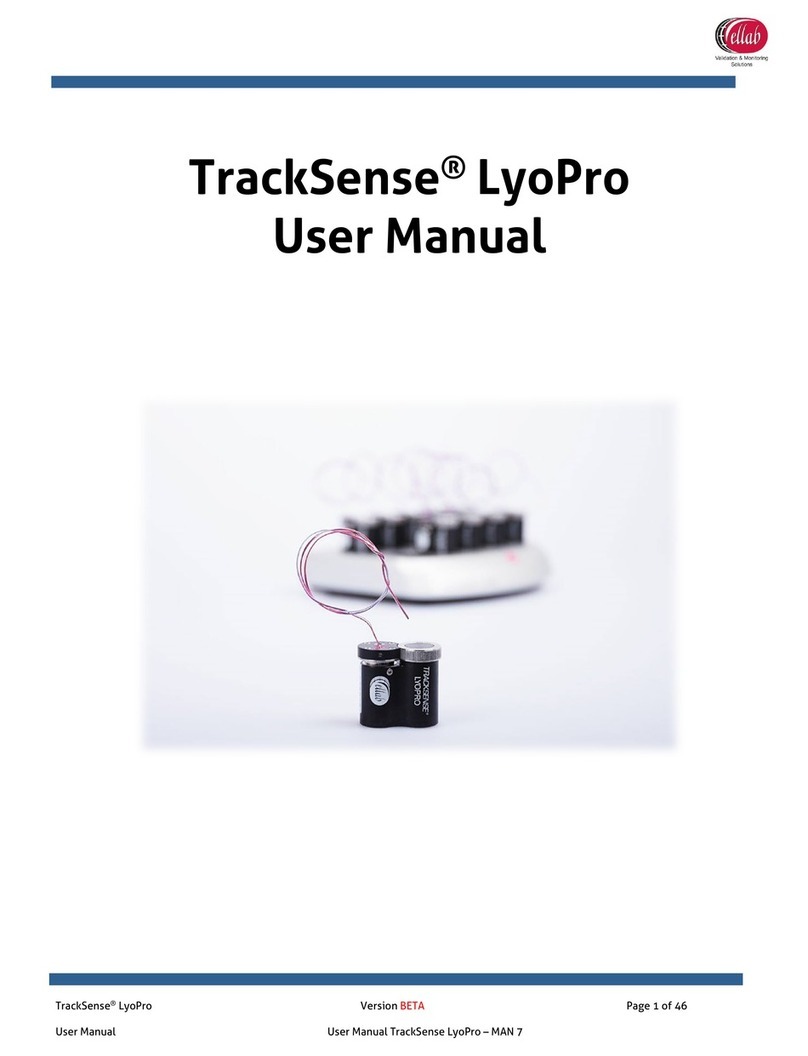
Ellab
Ellab TrackSense LyoPro user manual
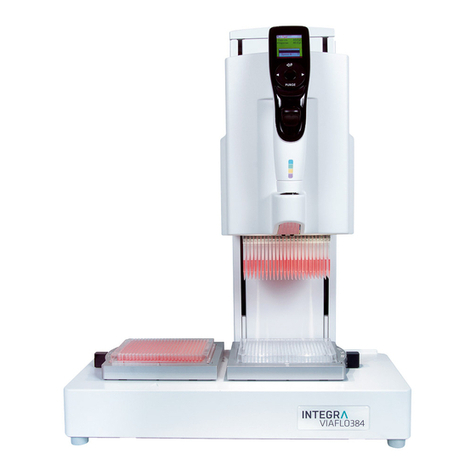
INTEGRA Biosciences
INTEGRA Biosciences VIAFLO 96 quick start guide
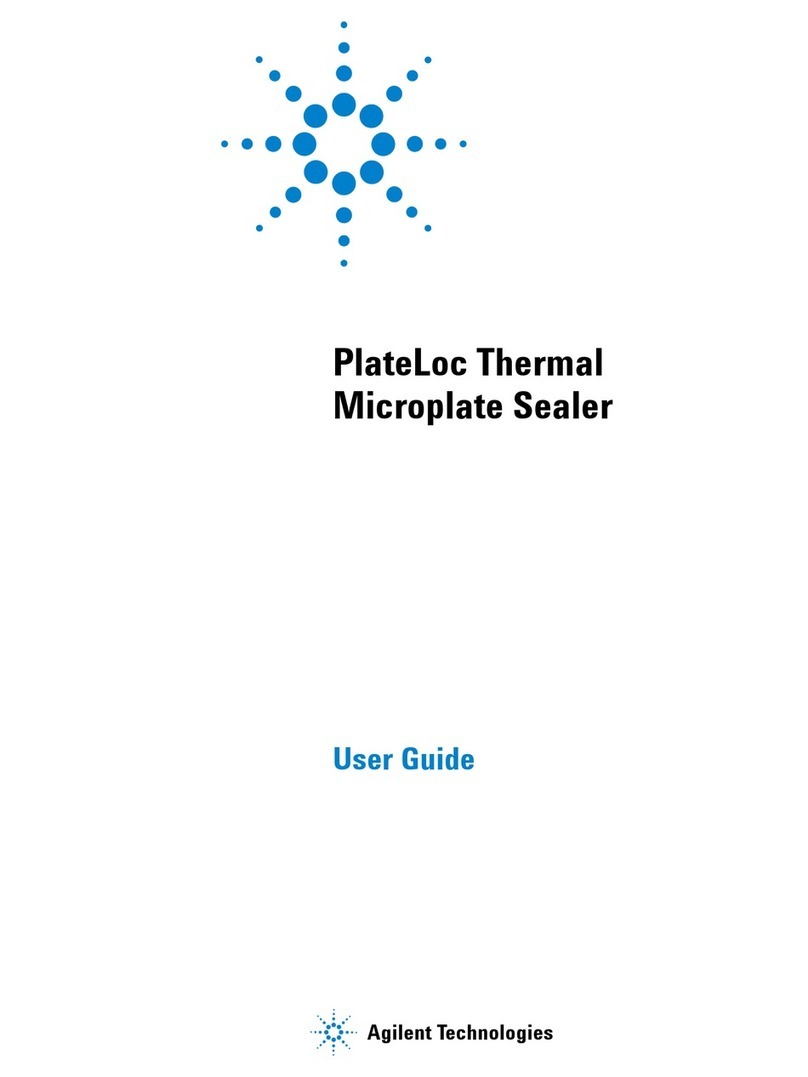
Agilent Technologies
Agilent Technologies PlateLoc user guide
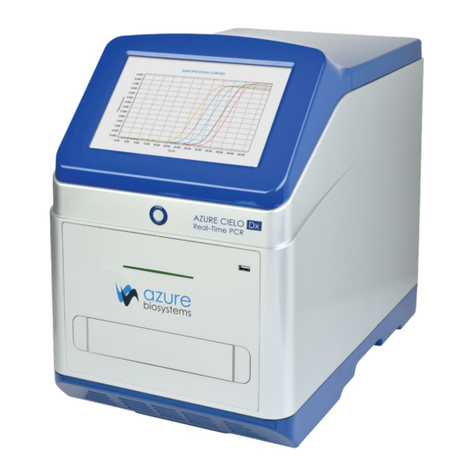
Azure Biosystems
Azure Biosystems Azure Cielo Dx AIQ314 user manual

cytiva
cytiva OligoPilot 400 operating instructions

Pacific Sun
Pacific Sun Kore 7th user manual
